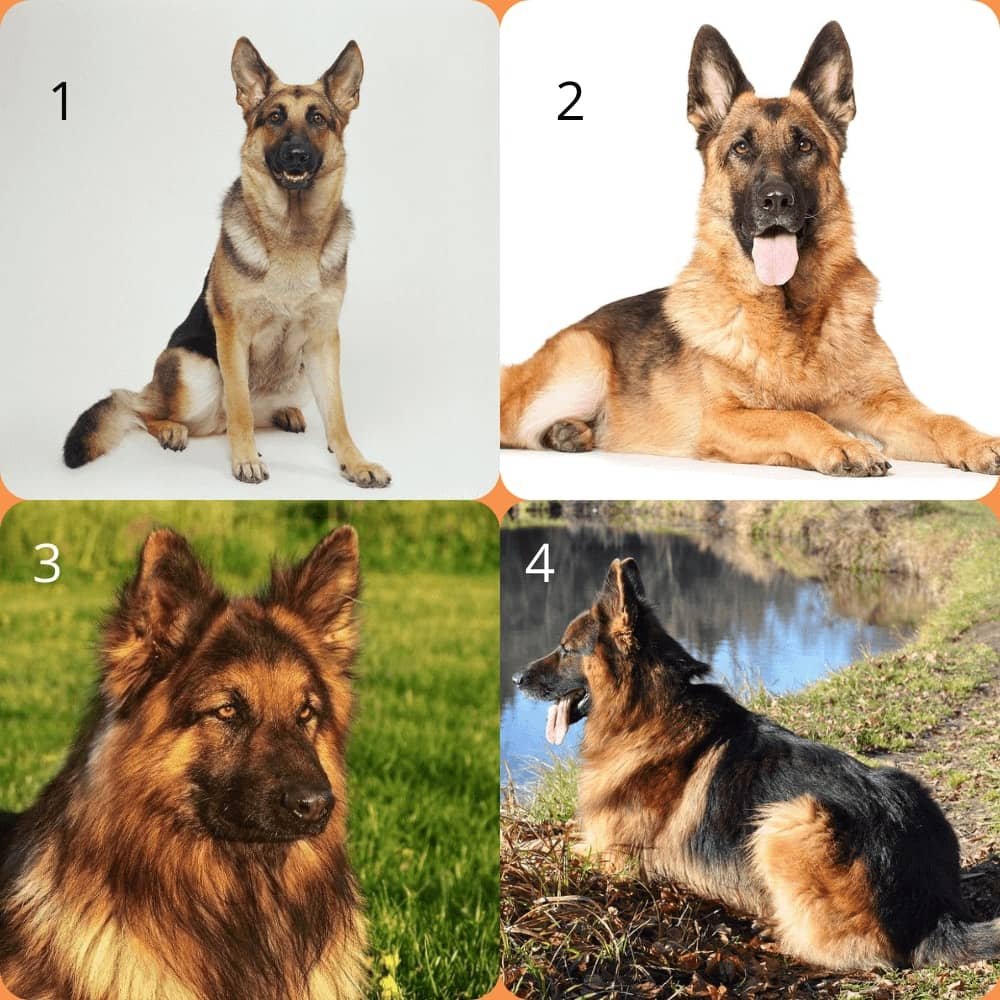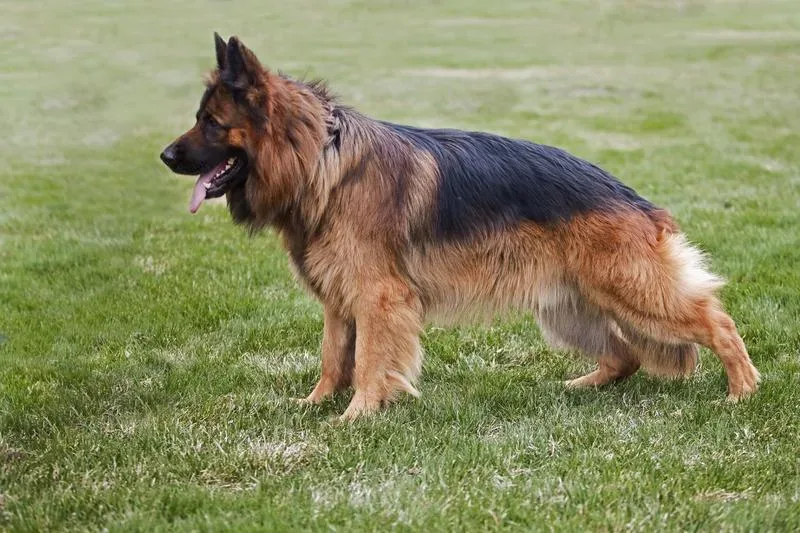Before we get into the details about long haired German shepherd and Short haired, we have to know that the German Shepherds are one of the most popular dog breeds in the world.
Their services have been utilized in many forms including police, military, therapy, search and rescue, guide dogs, and narcotics detection dogs. They also do well as pets and family dogs.
The most important feature of these dogs is their long shiny thick coat so-called Long Haired German shepherd.

The long-coat variation is caused by a recessive gene. Two short-hairs can have long-haired puppies in a litter if both parents carry the recessive gene.
Despite the fact their coat is longer, this variety of German shepherds has all the characteristics of a normal shepherd, except for their coat.
Also Read: Do Belgian Malinois shed more?
German Shepherds can be in solid color, sable color, saddleback color, or bi-colored.
Coat colors range from Blue Panda, black German Shepherd, white German shepherd, red Sable German shepherd, tan, blue, cream, liver, and silver.
You may have heard of a long-haired German shepherd while adopting a dog but you need to know what exactly is long-haired and short-haired in German shepherds because it is all associated with routine maintenance, temperament of the dog, low to moderate shedding, and supplements you need to give for your dog.
So how do you distinguish a long haired German shepherd versus a short haired German shepherd?
Short Haired German Shepherd vs. Long Haired German shepherd – What’s the Difference?

There are mainly 2 types of coats you often see or hear about German shepherds that is short haired German shepherd or long haired German shepherd. Long haired German shepherds will have an extra or second coated fur and that is known as “Guard Coat”, which protects the dog from dirt and water.
The long hair would shed off after the 1st month and the puppy looks like a normal short-haired German shepherd but the fur will again come back rigorously after the 5th month.
The second coat fur which is present in long-haired German shepherds is the guard coat and is usually foamy and soft that can avoid contact with the dirt and water off the dog’s skin which helps in preventing the itching.
The advantage of short hair is that it prevents mud on their skin or unnecessary bacterial infections.
Long-haired German shepherds that have a guard coat can provide dual performance at different seasons of the year.
During the winter, long-haired German shepherds will be able to hold the heat generated naturally close to the skin. In the summer, the foamy upper coat will be able to reflect sunlight, which will help the dog from getting too hot.
Long-haired German shepherds also have an undercoat. This undercoat serves as an excellent insulating coat in winter, the undercoat which we call a “Guard Coat” is thicker and stronger. This, coupled with the second coat, makes the long-haired dog well suited for all types of weather.
Short-haired German shepherds, on the other hand, only have a single outer protective coat. These dogs are generally not suitable for living in cold weather like Antarctica, Alaska, Kazakhstan, Finland, and Mongolia, which are considered as the top coldest places in the world, and in most cases, they are bred in areas that do not require an insulating undercoat.
So it’s a good idea to adopt a long haired German shepherd or a double-coated dog in the coolest locations.
German shepherd Hair Types

There are 4 different types of German shepherd coats or hair types including
- Short Haired: Short haired German shepherd will have 1 Inch hair with an Under Coat
- A medium-Hair German shepherd: Medium-Hair German shepherds are covered with an undercoat, commonly known as a Guard coat. These German Shepherds are very frequent and it is essential for the Show lines. This hair is usually between one and two inches long.
- Long hair with undercoat: These German shepherds will have at least two inches long hair, usually very thick with an undercoat, and make an excellent breed during winter.
- Long Haired without undercoat: Long Haired GSD which looks quite similar but the undercoat will be missing.
Coat Types and Shedding
One of the factors that affect the amount your dog does is their hair type. German Shepherd dogs are often referred to as German shedding dogs. These dogs bark most of the year, regardless of their coat. However, some types of German Shepherds may have less shedding and so if you adopt one, you should be prepared.
However, you should make sure to Groom your long-haired German shepherd regularly. It is best to brush once every two days, but if this is not possible, be sure to brush at least 3 times a week.
How often should you bathe your dog?
Bathing your German Shepherd can remove 20% more fur. If you brush only when your dog is slightly damp, it will help to remove more hair. Do not bathe your dog often, as this removes natural oils, making your dog coat easier to the mat and less shiny. It is best to avoid frequent bathing that is you can bathe the German Shepherd every 4-5 months.
German shepherds who do not have undercoats need less clothing during the spring-fall and autumn months, but there is no big difference in what it looks like.
Can you shave a German Shepherd?
German Shepherd’s undercoat serves as an excellent insulator, and it keeps them warm during the colder months. But fur coats keep them cool in summer and prevent them from warm air.
Therefore shaving a double-coated German shepherd is a very bad practice.
If you have one of these puppies or want to adopt one, it makes sense that you want to do everything you can to make its coat healthy and shiny. Proper nutrition and dressing habits are great ways to make sure your dog is happy and beautiful!
Long Haired German Shepherd Lifespan and Health Issues
Unfortunately, the long-haired German shepherd suffers from a wide range of health problems. Their lifespan is only 7-10 years. Sadly even for a large breed dog, it has a short lifespan.
Here are some health issues that your long haired GSD should address:
- Hip or elbow dysplasia – a painful condition in which the joints do not form properly
- Gastric dilatation – Volvulus (bloating) – a life-threatening condition in which the dog’s stomach fills with bloating and rotates on its axis, stopping the blood supply to the intestines.
- Degenerative myelopathy – a progressive spinal cord condition leading to paralysis
- Exocrine pancreatic insufficiency – a genetic disorder in which digestive enzymes are destroyed, and the dog does not digest food properly
- Allergies – Environmental or food allergies can cause a lot of skin and other problems
Not all German Shepherds have any of these health problems. However, you should budget for expensive surgeries or precautionary pet insurance to help your dog maintain their quality of life.
How much does a short haired German Shepherd puppy cost?
On average, you can pay between $500 and $ 2000 for a pet, or for a family dog-type short-haired German Shepherd from a breeder.
For short-haired German Shepherds with pedigrees, papers, work titles, specific lines, and proven controlled breeding history – you can pay thousands of dollars.
Medium / expensive coat GSDs are becoming more popular, so you may not pay much for short hair GSD.
When adopting a short-haired German Shepherd, you can pay $50 to $700 – which includes the adoption fee.
How much does a long haired German Shepherd puppy cost?
The price of long haired German Shepherds varies tremendously. You may adopt from a dog shelter for $50 to $250 or less. Or, you can find the most famous breeder and pay up to $ 2000.

